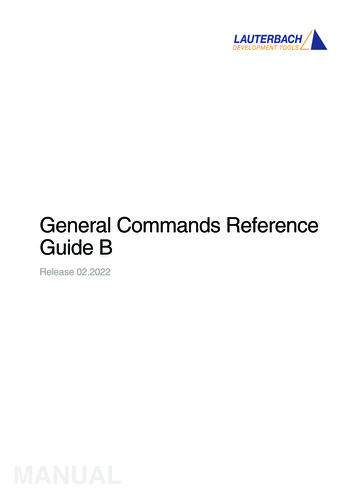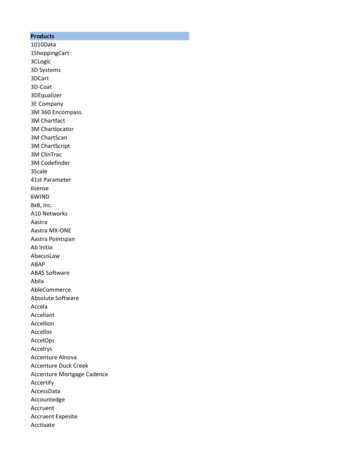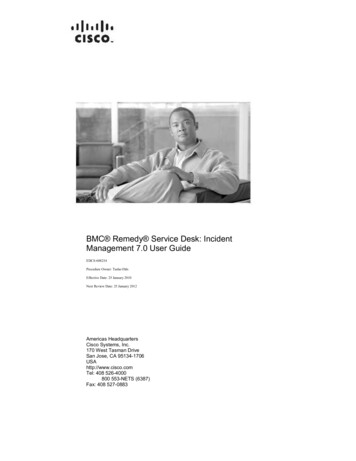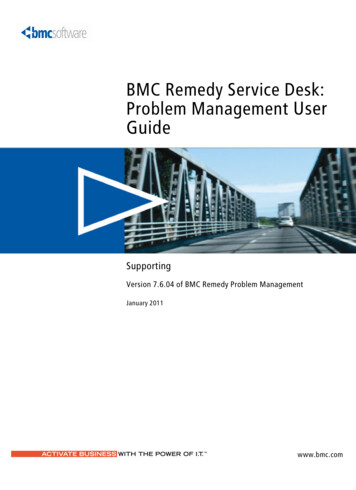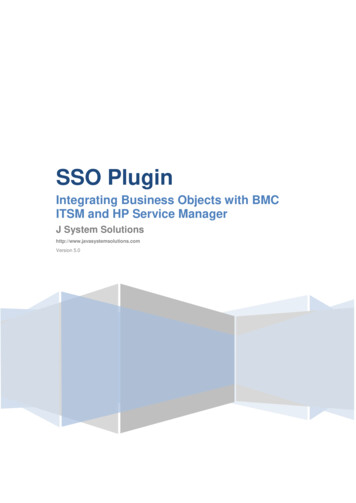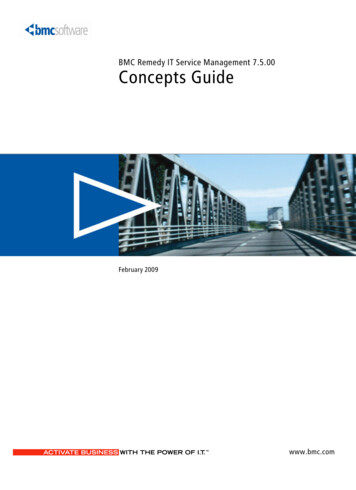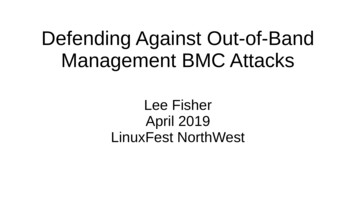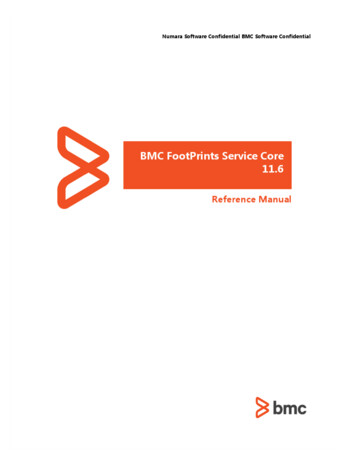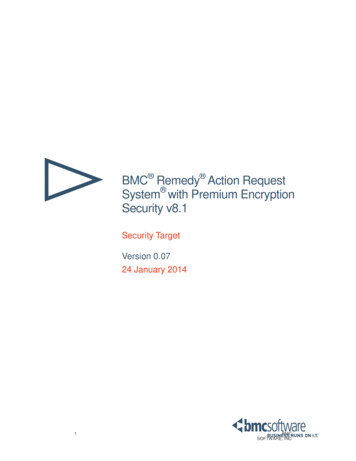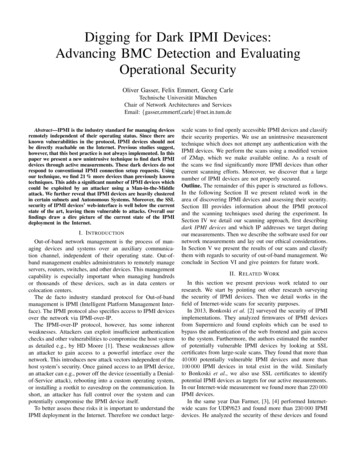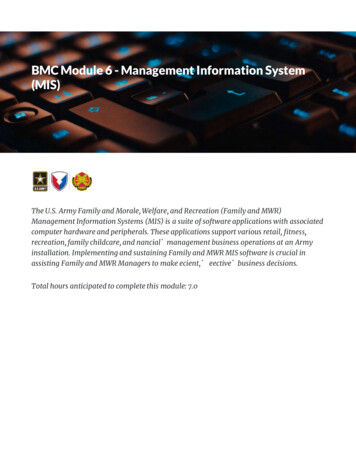
Transcription
BMC Module 6 - Management Information System(MIS)The U.S. Army Family and Morale, Welfare, and Recreation (Family and MWR)Management Information Systems (MIS) is a suite of software applications with associatedcomputer hardware and peripherals. These applications support various retail, tness,recreation, family childcare, and nancial ̀ management business operations at an Armyinstallation. Implementing and sustaining Family and MWR MIS software is crucial inassisting Family and MWR Managers to make ecient, ̀ eective ̀ business decisions.Total hours anticipated to complete this module: 7.0
Lesson 1 of 401.1 OverviewOverviewThe U.S. Army Family and MWR Management Information Systems (MIS) is a suite ofsoftware applications with associated computer hardware and peripherals. These applicationssupport various retail, . tness, recreation, child and youth services, andnancial managementbusiness operations at an Army installation.At the end of this lesson, you will be able to:1Summarize the reasons why Family and MWR established automatedmanagement systems.2Describe the composition and functions of the Con guration Control Board.3Explain the bene ts of Management Information Systems.
Lesson 2 of 401.2 Why Did Family and MWR Establish AutomatedManagement Systems?Inscal year (FY) 1992, prior to the establishment of the Board of Directors (BOD), theFamily and MWR Executive Committee conducted a survey and found that Family and MWRManagers reported that their manual processes were roadblocks to e ective management.The survey showed that Family and MWR Managers were spending 70-80% of their total timepushing labor andnancial management paperwork. With three-quarters of their timedevoted to paperwork, managers weren't able to do their jobs.As a result of the ineciencies identi ed in processing data manually, the Family and MWRMIS project was established. The goal was to provide hardware and software tools so thatFamily and MWR Managers could access data to use in decision-making and eliminatemanual processes of data collection. The MIS would reduce the time required to complete atask so managers could redirect their e orts to providing better service to their customers.Management Information System Steering CommitteeThe Management Information System Steering Committee (MISSC)concentrated on the corefunctions that Family and MWR Managers must perform, which are:Workforce managementFinancial managementBudgetingParticipation and scheduling
Procurement and inventoryGolf managementMarketing and servicesThe committee used speci cations in the functional descriptions to establish the evaluationcriteria for available commercial o -the-shelf (COTS) solutions. If a software program wasavailable commercially, it had to meet 80% of the Family and MWR requirements. Centralfunding was approved in October, 1994 and theelding process began soon afterward.
Lesson 3 of 401.3 MIS Oversight by the IMCOM G6 Con gurationControl BoardThe MWR Enterprise Configuration Control Board (CCB) was replacedin 2011 by the IMCOM G6 Configuration Control Board.This CCB is established as anInternal process for IMCOM andis focused on more than justMWR systems. The CCB meetsbi-weekly and is chaired by theIMCOM G6 Enterprise SolutionsDivision Chief.
1Review functional requirements and prioritize for work2Assign and adjust workload to achieve deliverables3Approve system releases based on validated test results4Approve System Sprints for development e orts5Ensure IA Compliance6Review architectural changes and approve the same7E ect change to DIACAP documentation
Lesson 4 of 401.4 Oversight by the Con guration Control BoardGuidelines for a requirement to become a project:For a requirement to become a project the requirement must be fully vetted within the subordinateDirectorate and have the respective Director's approval. This is done using a semi-formal requirementsdocumentation process. Once the requirement documentation is received, a Program Manager is assignedwho will work with the functional to ascertain the complete requirements and develop a project plan. Theproject plan is then reviewed for feasibility and recommendations are made to contract out, develop inhouse, or incorporate the new requirements into another system. Cost estimates are provided to thecustomer based on the review and a determination is then made on the way forward.
Lesson 5 of 401.5 MIS Project RequirementsIn addition to this internal IMCOM process, Congress established with the NDAA 2012, a requirementfor all systems to be certiedbefore funding can be requested and applied to the requirement. This isan extensive process that requires a review at HQ Department of the Army before DoD certication.This review requires full Business Case Development, Business Process Re-engineeringDocumentation, and supporting diagrams of operational workow processes.The IMCOM CCB then becomes the starting point for the requirements that meet the thresholds forDoD certication.IMCOM G9 has an internal process that looks at all investments and determines which requirementsare funded. This is considered a feeder process to the IMCOM G6 CCB and is critical to meeting theneeds of FMWR program managers.
Lesson 6 of 401.6 What Are the Bene ts of MIS to Family and MWRManagers?Before the deployment of MIS, many experienced Family and MWR Managers had developedtheir own systems to process manual data by using spreadsheets and performing extensive,time-consuming analysis. The suite of Family and MWR MIS programs can perform this"stubby pencil" work more rapidly and with more detail and greater accuracy. These systemscan eciently provide a manager with information to assist in such tasks as:1Operating the program.2Planning and marketing activities.3Preparing and revising budgets.4Analyzing patron usage.5Projecting future requirements.
Access to information on a timely basis enables eectivemanagement in today's constantlychanging Army Family and MWR business environment. Each Army MIS can produce a variety ofinformational reports that can save a manager time, energy, and money.With just a few computer keystrokes, a golf course manager can ndout how many rounds of golfwere played yesterday, last week, last month, or on the previous 52 Mondays. TheOcer'sClub manager can check to see the amount of overtime paid in the last pay period or thelast year.Types of Information AvailableExamples of information that the MIS provides are:Extensive nancial and statistical reports.Multiple database entry.Demographic analysis.Target marketing.Pass management.Waiting lists.Inventory management.Managers' Responsibilities for MIS UsageThese systems are not limited to the capabilities just described. To fully bene t from thesesystems, managers must:Have the systems in place.Enter accurate and complete information into the database.Learn which reports are available from the system and how to access them.
Lesson 7 of 401.7 The Future of Family and MWR MISNAF Integrated Financial & Management System (NIFMS)Currently, NAF nancialprocesses operate on a patchwork of non-integrated systems leading tobusiness process inecienciesand accurate nancialat all levels of the organization. Managers struggle to obtain timelyperformance information as noted as a nancial structure deciencyby boththe US Army Audit Agency and our commercial auditorsProviding upgraded nancial ̀ management technology will support analytical capability enhancingmanager eciency, ̀free labor, and promote business process standardization and simplication ̀across the NAF enterprise.The NAF Integrated Financial & Management System (NIFMS) is an enterprise solution addressingaudit ndingsand other limitations in the current NAF business environment. The system willdeploy integrated enterprise business applications for nancialmanagement and payroll,consolidate multiple accounting operations, eliminate redundant systems, and replace agingsystems. Goals for this eortare to reduce operational costs, improve the quality and timeliness ofinformation provided to NAF business and military leaders in order to improve decision making, andto comply with Information Technology (IT) security requirements.Approved Mission Statement: Deploy an Enterprise-wideFinancial Management System to modernize accounting practicesand capabilities (revenue/expense tracking, payroll, time andattendance, accounts receivable, accounts payable, fixed assetmanagement, and cash management).
Lesson 9 of 402.1 OverviewProviding for Family and Morale, Welfare, and Recreation for the entire U.S. Army is no smalljob. To oversee everything from non-commissioned oservices, bowling centers to golf courses, andcers' clubs to child and youthtness centers to marinas, for example, takessigni cant human resources. It is a daunting task to process the time and attendance reportsfor such a geographically diverse workforce. Prior to the purchase andautomated system, the process was ineelding of ancient and very time consuming. EPAY BlueForceallows Family and MWR programs to automate the collection, processing, and transfer ofdata, the scheduling of employees, and the production of reports to assist in ecientadministration of the nonappropriated fund (NAF) personnel program.At the end of this lesson, you will be able to:1De ne EPAY BlueForce.2Identify the functions of EPAY BlueForce.3Identify reports produced by EPAY BlueForce.4Explain the bene ts of EPAY BlueForce for the Family and MWR Manager.
Lesson 10 of 402.2 What is EPAY and What Does it Do?EPAY Systems is a commercial-off-the-shelf (COTS) applicationdesigned to provide total automation of time-and attendance relatedfunctions for NAF employees.EPAY is a web based system that collects time and attendance dataeither from a WalTer Timeclock or from employee work schedulesstored in the system accessible via WebPunch.WebPunch login for employees.Once supervisors review, edit (if necessary) and approve time sheets in BlueForce they aresent to NAF Financial Services so that employee pay checks can be processed.EPAY Blueforce Process Map
BlueForce DashboardEPAY BlueForce gives activity managers the ability to manage employee time andattendance for greater productivity and pro t by providing a more cost-e ective method ofgathering, analyzing, and reporting this data.Special features of EPAY BlueForce include:Dashboard where supervisors can edit and approve timecards.Approve Personal Time O(PTO) requests.Automated DA Form 4850 (Time and Attendance Card).Advanced scheduling.Flexible data entry options.Reduced paper environment.
Lesson 11 of 402.3 What Are the Functions of EPAY BlueForce?EPAY BlueForce provides managers with accurate data on labor costs and information on stawork-related matters at each location in real time. Information about the NAF labor force isalso immediately accessible. EPAY allows managers to monitor:Overtime hours.Premium and shift di erential hours.Employee schedules compared to actual hours worked.Who is late or absent.Who has taken exception hours, such as sick time, family leave, holidays, etc.How many hours have been worked in a certain time period by department or employee.EPAY provides valuable information to assist in analyzing business processes, preparing orrevising budgets, and recommending changes to programs.
Manage ShiftsTimesheet for Employee Submittal
Supervisors can edit and add punches to an employee timecard.PTO requests pending approval.
Lesson 12 of 402.4 The Bene ts of EPAYAutomating time and attendance has saved a staggering amountof money in the past.For example, carbon copy forms for time and attendance used to be mailed from the Texarkana,Texas-based payroll center every two weeks. Once the time and attendance cards were lledoutat the installation, one copy was mailed to the recipient and one to Texarkana for record keeping,check production, or electronic processing. Paper and mailing costs have now been eliminated byuse of an automated system.Additional ecienciesinclude reduction of errors, elimination of redundancy, removal of bias,and reduction of paperwork and paper storage. The benetsof EPAY also include increasedproductivity, improved labor management and control, and enhanced employee empowerment.Reduces ErrorsWhether it's using the wrong data or transposing numbers in a work center code, errors arebound to occur when time is recorded manually. An automated system reduces the risk of errors.Eliminates RedundancyAs many as four or more departments may input the same employee data for their own particularneeds. Automation allows everyone to tap into the same reservoir of information, so that inputand changes need only be made once.Removes BiasAdditional ecienciesinclude reduction of errors, elimination of redundancy, removal of bias,and reduction of paperwork and paper storage. The benetsof EPAY also include increasedproductivity, improved labor management and control, and enhanced employee empowerment.Everyone interprets information in a slightly dierentmanagers interpret pay rules dierently.to everyone.way. This can be a serious problem ifEPAY helps to guarantee that rules are applied equally
Reduces Paperwork and Paper StoragePhysical timesheets and time cards can mount up quickly on anyone's desk, but imaginethe volume in the payroll oce and every Family and MWR activity. And every two weeks,there are more on the way. Time systems track information electronically, eliminating theneed for paper record keeping and making easy work of data transfer.Increases ProductivityManagers no longer need to spend hours gathering data for labor reports, answering laborinquiries, or entering piles of data. Their time can be dedicated to other important tasks.Improves Labor Management and ControlTime and attendance data can be used to evaluate productivity of an entire program or of aparticular department, project, or worker. From activity-based costing to performanceevaluations, automated time systems can be used to analyze and improve many aspects ofa business.Empowers EmployeesTime and attendance systems enable employees to check information quickly and easily,and allow them to have their pay automatically deposited in their bank accounts.
Lesson 14 of 403.1 OverviewFamily and MWR Managers oversee numerous business processes in the operation of theirprograms. In order to standardize these processes, enhance accountability, share informationfrom one activity to another, and track customer preferences for better service, the Armyutilizes the Family and MWR Management Information Systems (MIS).As part of this suite of software applications, RecTrac is designed to track business operationsfor facilities such as physical . tness centers, bowling centers, leisure travel, golf courses, andoutdoor recreation centers. Maintaining a broad range of operations, the system providesautomated solutions to handle many tasks faced by Family and MWR Managers.At the end of this lesson, you will be able to:1Describe RecTrac2List the ten RecTrac modules and summarize their functions3Identify the most commonly used RecTrac reports4Explain the bene ts of RecTrac
Lesson 15 of 403.2 What is RecTrac?RecTrac is a software application for Family and MWRactivities that oersextensive help in handling day-to-day operations such as registrations, point of sale,inventory management, and rental management.RecTrac also provides program planning, marketing,and evaluation assistance.RecTrac is the primary MIS application formanagement of activities including:Fitness centers.Snack bars.Recreation centers.Bowling centers.Automotive skills centers.Outdoor recreation centers.Equipment issue centers.Marinas.Arts and crafts centers.Golf courses.Warrior Zones.
RecTrac provides . nancial management capabilities by:Tracking income and expenses for each individual activity, facility, or pass type.Running Daily Activity ReportInventory reports that are commonly used for reporting and monitoring forstock levels.Printing activity specicforms for each registration or transaction.The household screen provide on page 3 of 24 can be customized in 10.1 and 10.3to meet the facility/activity needs regarding HH information.The RecTrac database is PII/PIA compliant and meets the Federal InformationProcessing Standards (FIPS 140.2) for security and encryption compliance.Expense tracking in RecTrac is limited - tips payable, inventory costs and a fewother expenses based on capturing for charging customers.For example, RecTrac has statement, invoice, and installment billing capabilities. Daily Activity Report(DAR) and cash receipt journals are electronically produced. In fact, RecTrac has the capability ofproducing over 300 informative reports the manager can use in planning, operating, and evaluating theprogram.RecTrac can be used with either a touch screen or keyboard. Customizable screens provide operationalsecurity and ease of use for operators.All computers with RecTrac installed are connected to a centralized database that allows sharing ofinformation between activities. Data elds,such as name of customer, phone number, or identicationcard number, can be accessed by all activities. Training Tip: RecTrac can also be programmed with Hot Buttons. These are user de nedobjects on the main RecTrac screen that toggle the user to any commonly used programthey choose. For example, if you do most of your work in the Daily Processing functionalarea, but you often run a few reports or inquiry programs, you can set up Hot Buttons toallow you to run these programs without leaving Daily Processing.
Lesson 16 of 403.3 RecTrac Modules and Their FunctionsDierentFamily and MWR sites on the same installation usedierentportions of RecTrac, called modules, which aretailored to the business procedures performed in eachactivity. RecTrac has ten fully integrated modules that sharethe same central database of households, activities, passes,facilities, etc.RecTrac Main Function Screen is also customizable (seebelow) to the user. In 10.3, this can be adjusted even moreadding windows to keep a manager up to date and dailysales, reservations/registrations or other key things amanager may want to monitor "real time live".Most users will not use all eleven modules—only the ones relevant to their businessprocesses.
As transactions are processed in any module, the database recordsare simultaneously updated in real-time. Data is entered once and isshared by all modules for receipting, reporting, and nancialanalysis functions.For example, the system can process transactions from anycombination of modules and produce a single receipt. It can trackincome and expenses for each individual activity, facility or passtype.Activity ModuleThe Activity Module enables management of the enrollment process including:Activity, program, and class registration.Prerequisite enrollment options.Transfers.Cancellations.Waiting lists.The system can:Manage and produce a roster or waiting list.Generate mailing labels and marketing brochures.Track class attendance and instructor schedules.The Activity Module assists innancial management by:Tracking income and expenses for each individual activity.Generating statements, invoices, and installment bills.Prorating fees and calculating surcharges automatically.
Facility ModuleThe Facility Module is integrated with other modules so it o. ers the capability to moree ciently manage facilities by checking availability and tracking overlap facilities to preventdouble bookings.This module provides several other tracking capabilities including:One-time and pattern reservations.Setup and cleanup times.Maintenance schedules.Other functions include:Automatic con ict-booking resolution.Rain date rescheduling.Printing reservation rules and regulations.The Facility Module also provides information for nancial management.It has the capability totrack income and expenses for each facility, as well as track fees including damage deposits.Pass Management–Using the Pass Management Module, a manager can determine pass and ID card statistics andcontrol access to programs or facilities.The Pass Management Module has the capability to produce professional-looking, photo IDmembership cards for weekly, monthly, or yearly needs. The system can be activated to showthe photo of the patron every time the pass is swiped.Through use of these passes, a manager can gain information about demographics andprogram or facility usage. The pass can also be used to check membership eligibility andenhance security.The Pass Management Module furnishes nancial information such as income and expense foreach individual pass type. It tracks guest,additional, and daily entry fees, as well as identi espass membership,suspension, and expiration dates.
Point of Sale (POS) ModuleThis module provides important business features including:Point of Sale cash register functions, regular and receipt inventory control, and ticketsales.Multiple forms of payment acceptance, such as credit cards, for a single transaction withdetailed receipt printing abilities.Tracking of sales tax, discounts, and gift certi cates.Inventory and vendor tracking.Identi cation of transfers and spoilage.Barcode and Universal Product Code (UPC) scanning.This module also supports cash drawers, bar code readers, 40/80 column receipt printers,touch screen and programmable keyboards and keypads, and magnetic stripe readers.Rental ModuleThis module provides regular rental processing for equipment such as camping gear or forsites such as shelters. It is one of the most important modules for outdoor recreation. Thismodule assists the manager in:Processing reservations for equipment and sites ahead of time.Tracking equipment check-in and checkout times.Tracking rental fees including deposits, automatically.Calculating early return and late fees, automatically.In addition, this module can con rm the renter's certi cations,driver's license, age, and otherrequirements necessary for rental eligibility as part of the transaction.
Trips ModuleThis module assists the manager by booking reservations and easily generating a trip roster. Italso has the ability to set a minimum or maximum count and create waiting lists for excessparticipants. Trip allows for a POC name and number that will be with the group. Activityrequires individual information.Locker ModuleThe Locker Module assigns lockers and locks for both men's and women's lockers. It tracks:Locks, including combinations.Damage deposits.Locker reservations.Renewals.The module will alsoag rental fees when they are due.League ModuleThis module schedules leagues and tournaments, reserves facilities, and schedules the o cialsor referees. Also, the league module MUST BE used to capture rosters and teams for advancingin the Unit Level Intramurals through Army Sports.It can:Track player and team statistics.Report team standings and tournament brackets.Generate the team and/or master schedule.Courts ModuleThe Courts Module has the capability to provide quick advanced court reservations and makereoccurring or multiple reservations at one time. Additionally, it can beset to allow or restrictgroup bookings.
Golf ModuleGolftrac, at one point a separate piece of software, is now a module of RecTrac with speci cfeatures for golf course operations. It o ers the POS system and inventory control capabilities,automatic-pricing options for the Pro Shop and snackbars, and numerous nancial andoperational reports.In addition, the Golf Module can:Generate tee time slots for reservations.Pattern tee time reservations.Track tournaments for single or multiple courses.Calculate and record handicaps for golfers to meet PGA requirements.Set up pass and ID card templates to print golfer ID (bar code) labels or golfbag tags.Generate gift certi cates, either one at a time or by groups.Apply gift certi cates or cash back calculations to fees.10.3's smart phone feature allows the starter to pull up the tee sheet for con rming thestart. However most Garrisons still use the GHIN (Golf Handicap and InformationNetwork) system for handicap reporting since it is USGA's standard.The Golf Module alsoprovides a way for managers to track the weather, which can be useful since golfpro tability is often dependent on the weather.CYMS Module for Staff Records SystemRecTrac's CYMS module also provides a system for maintaining stathis system includes the following types of information:records. The database forPersonal and position data.Background checks.Medical requirements.Recognition and awards.Administrative actions.Secure method for capturing data in a single locationThe Sta section of the RecTrac's CYMS module also provides the capability to maintainrecords on volunteers and coaches. For example, a manager would be able to nd out howmany coaches volunteered last year for the basketball program or the status of certi cates forthe coaches during the current year. Employee training records allow for reminder to makesure employees do no miss the annual training date. Using RecTrac to track employee trainingallows for consolidated reporting for Annual Historical Reviews or other key information. Itwill allow for surprise cash count results to be annotated along with events where theemployee has executed above their job scope to provide a single location to compile data foremployee reviews.
Lesson 17 of 403.4 Commonly Used RecTrac ReportsRecTrac provides over 300 standard reports that are helpful intracking and comparing the information required to operate asuccessful activity and plan for the future.While each of the ten modules provides a variety of reports, not all may be relevant to every manager.The usefulness of each report will depend on the type of activity and the functions required. Thenumber one report is the Daily Activity Report. The inventory reports are also one of the mostcommonly used for reporting and monitoring for stock levels.There are, however, some modules that are common to almost all managers who implement RecTracand every manager should become familiar with the key reports provided by these modules.
The modules that are most commonly used across Family and MWR activities are:Activity Module ReportsThe Activity Module reports provide information about activity, program, and classregistration. The manager can create reports to determine the amount of fee-income collectedand other nancial information about an activity, ranging from instructor cost to mailinglabels printing cost.The Activity Roster Report provides invaluable information about the activity, such as:Date, time, meeting days, and location of activity.Maximum and minimum number of enrollees, waiting list, and current enrollment.Resident/nonresident information.Instructor name.Names of primary guardians and emergency contacts with phone numbers.Having this information readily accessible could come in very handy in providing informationto a customer about the availability of lessons or in notifying an emergency contact about anenrollee.Facility Module ReportsThere are over 35 di erent reports in the Facility Module. These reports provide the managerwith information about facility usage, such as what facilities are reserved, by whom, and when.In addition, the historic information found under Statistical Usage Reports can help inbudgeting and providing justi cation when requesting additional funding.For example, the Location Statistical Report allows a manager to print out a calendar for a day,week, or longer showing location reservations. It also provides:Number of times the location has been reserved.Number of people in the location.Amount of money, if any, collected for the location.
Pass Module ReportsThe Pass Module has the ability to provide reports for membership, nancial, visit, andstatistical data. Since it is important for Family and MWR Managers to be knowledgeable aboutusage, the Pass Module can be very helpful because it has the capability of tracking who thecustomers are, what activities or facilities they use, and when they use them. This informationis useful in marketing and evaluating programs and planning for the future.The extensive Pass Module Financial Reports are also very important for the same reasons. Thenancial reports are especially useful at budget time because the historical information thatmanagers need to make informed decisions is easily accessible.Point of Sale Module ReportsThe Point of Sale Module is one of the most used modules in RecTrac and the more than 40reports provided by this module can be very helpful to managers. The most commonly usedreports are those that provide information about inventories. An activity manager can producean inventory report for month end, pricing, and reordering.This module also provides reports on tickets sales from Tour and Travel o ces. These ticketreports include information about the commission charged, ticket pricing, and inventory.Another useful report is called the "What's Hot What's Not" report. This report identi es thetop selling item in the activity or Family and MWR. It can also indicate the worst selling item.This information can be of help to managers in making decisions about what to o er and whatnot to o er for sale in an activity.
Other Useful RecTrac ReportsOther useful RecTrac reports provide managers the capability to track usage,patronage,nancial data, and demographics for marketing, budgeting, planning,and evaluation purposes. These include.Rental Module ReportsThe Rental Module is mainly used in outdoor recreation for processing rentals of boats, campinggear, cabins, campgrounds, shing,and skiing equipment. When an activity uses RecTrac,numerous reports are accessible at a ngertipto provide information about who is renting theequipment and for how long.The nancialreports provide income and expense information while others give usageinformation. All of these reports provide data helpful in
signi cant human resources. It is a daunting task to process the time and attendance reports for such a geographically diverse workforce. Prior to the purchase and elding of an automated system, the process was ine cient and very time consuming. EPAY BlueForce allows Family and MWR programs to automate the collection, processing, and transfer of
